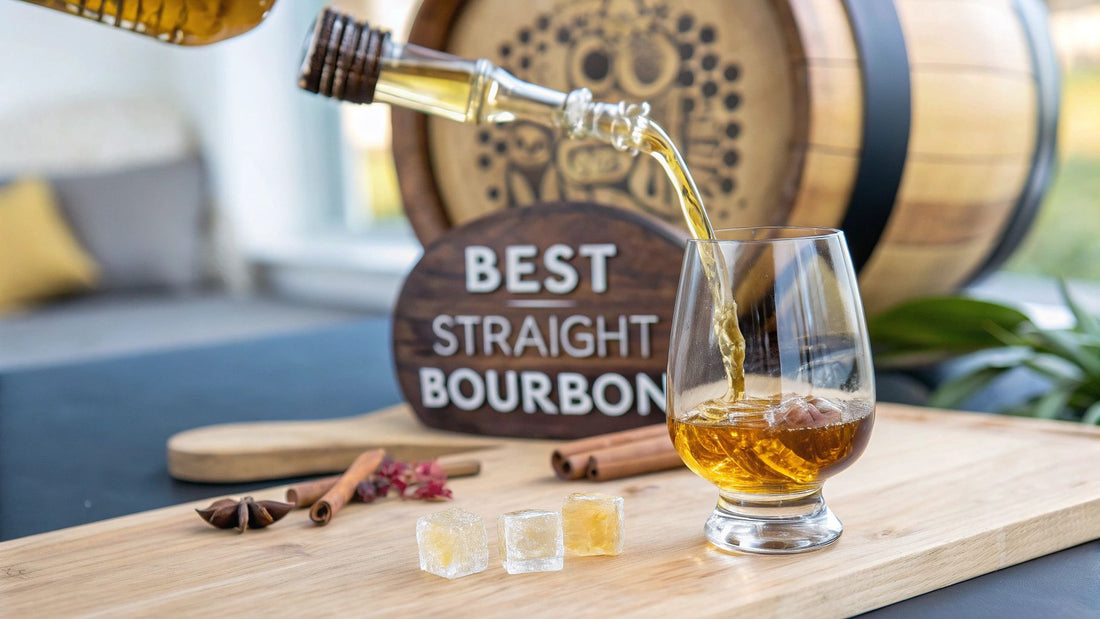When it comes to the best bourbon for drinking straight, it all boils down to your personal taste. The sweet spot is a delicate dance between smoothness and complex flavor. A great starting point? Look for bottles with a proof between 90 and 115 and an age statement of at least four years. This usually signals a well-rounded, mature character that's perfect for sipping neat.
Finding Your Ideal Sipping Bourbon
Welcome to the incredibly rewarding world of enjoying bourbon straight. If you're a new whiskey drinker, the thought of sipping it without ice or a mixer might seem a bit intense. But trust me, it’s the purest way to experience the spirit’s true character and everything the distiller intended. This guide is your map for a confident and enjoyable journey, turning every pour into a genuine experience.
We’re going to demystify how to choose, taste, and appreciate bourbon on its own terms. Forget the old myth that high proof automatically means harsh. The right bottle can deliver an explosion of flavor with remarkable smoothness, especially when you explore the innovative world of American craft whiskey.
What Makes a Bourbon Great for Sipping
To find the best bourbon for drinking straight, you’ll want to focus on a few key traits. These elements work in harmony to create a balanced, satisfying pour that doesn’t need anything extra to shine.
- Balance: A great sipping bourbon harmonizes its core flavors—sweet, spicy, oaky, and fruity. No single note should scream for attention or overwhelm the others. It's all about teamwork in the glass.
- Smoothness: This isn't about a lack of flavor. Not at all. It refers to a pleasant, velvety texture and a finish that warms you up without a harsh alcoholic burn, making every sip something to look forward to.
- Complexity: The best neat pours offer layers of flavor that evolve from the moment you raise the glass to your nose to the long, lingering finish. Think of it as a story that unfolds with each taste.
Before we dive deeper, here's a quick cheat sheet for new whiskey drinkers on what to look for when browsing the bourbon aisle.
Key Traits of a Great Sipping Bourbon
| Characteristic | Why It Matters for Sipping | What to Look For on the Label |
|---|---|---|
| Proof/ABV | Determines the intensity of flavor and alcohol heat. Higher proof often means more concentrated flavor, but can be intense for newcomers. | Look for 90-115 proof (45-57.5% ABV). This range usually offers a rich flavor profile without being overpowering. |
| Age Statement | Time in the barrel mellows harshness and adds layers of complexity, like notes of oak, caramel, and vanilla. | A minimum of 4 years is a good starting point. "Straight Bourbon" guarantees at least 2 years, but more time is often better for sipping. |
| Mash Bill | The grain recipe dictates the core flavor profile—corn for sweetness, rye for spice, and wheat for a softer, sweeter character. | Phrases like "Wheated Bourbon" (softer), "High-Rye Bourbon" (spicier), or simply checking the distillery's specs can give you clues. |
| Balance | A well-balanced bourbon ensures no single flavor (sweet, spicy, oaky) dominates, creating a more enjoyable and harmonious sip. | This is less about the label and more about reputation. Look for reviews that mention words like "well-rounded," "integrated," or "balanced." |
This table is just your starting point. The real fun begins when you start exploring and discovering what truly resonates with your palate.
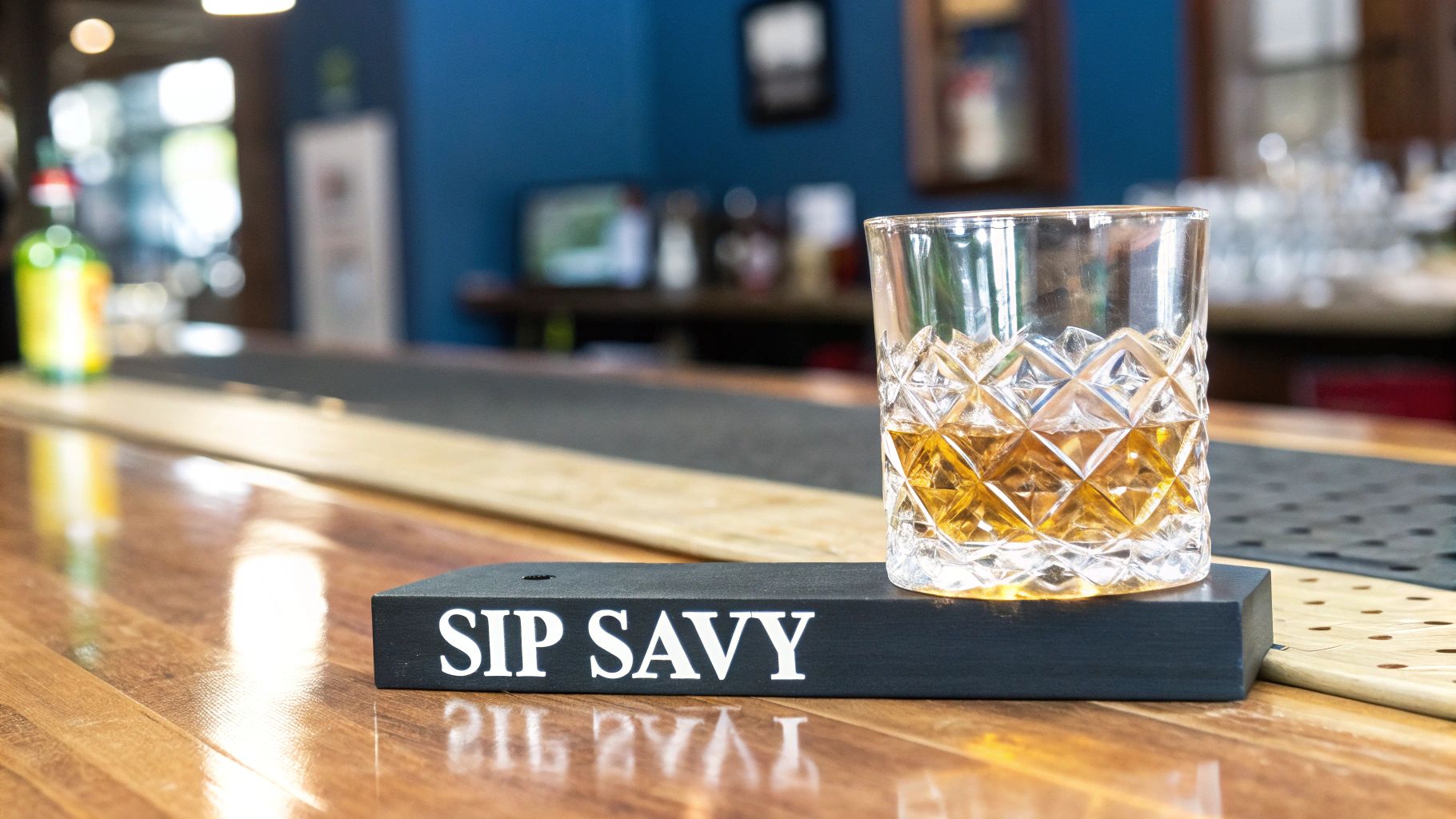
Many incredible American craft whiskey brands excel at creating spirits that are practically made for sipping. These smaller distilleries often pour their hearts into unique grain recipes and meticulous aging, resulting in bourbons with distinctive personalities perfect for your next pour.
For new whiskey drinkers, here's a pro tip: start with a bourbon around 90-100 proof. This range typically delivers a full-throttle flavor experience without the overwhelming intensity of a cask-strength monster. It's the perfect training ground for your palate.
How to Properly Taste Bourbon
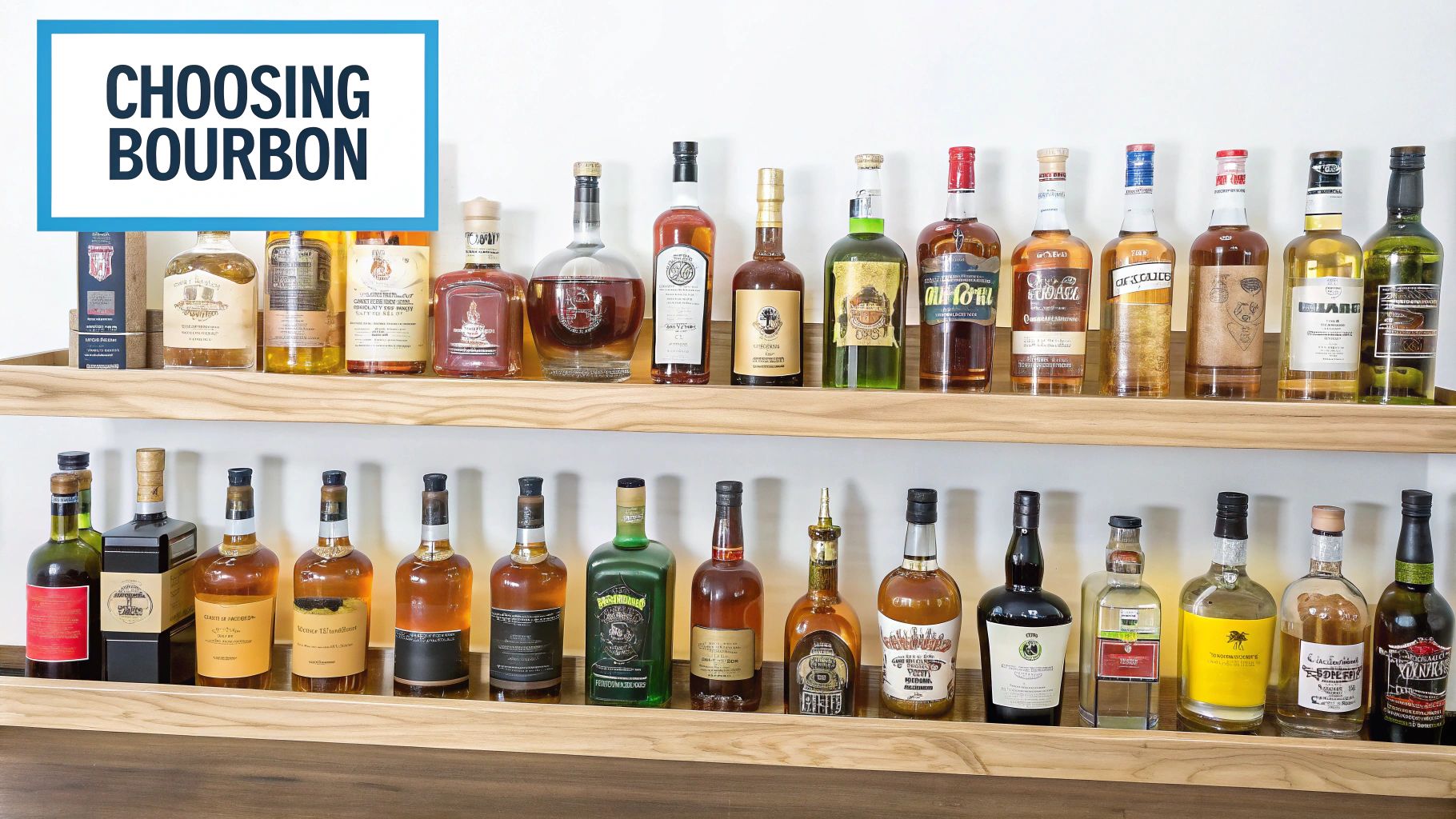
Before you can really pinpoint the best bourbon for drinking straight, you have to learn how to listen to what the whiskey is telling you. Truly tasting bourbon is a full-on sensory experience that goes way beyond just taking a swig. By following a few simple steps, you can unlock the complex flavors and aromas hiding in every bottle, turning a simple drink into a fascinating exploration.
This isn’t about being a snob; it’s about genuine appreciation. Think of it like finally listening to your favorite album on a great pair of headphones instead of through your phone’s tiny speaker—you just hear so much more of what the artist intended. The right techniques simply help your palate pick up on the subtleties that make each bourbon unique.
Start with the Right Glassware
Your tasting journey begins with the right vessel. Sure, any glass will hold bourbon, but a proper tasting glass is specifically designed to concentrate those all-important aromas, making them much easier to identify.
- The Glencairn Glass: This is the undisputed champion of whiskey tasting. Its iconic tulip shape captures aromas and funnels them right to your nose, while the solid base feels great in your hand.
- A Rocks Glass (or Tumbler): While it's the go-to for many, the wide opening lets all those delicate aromas escape into the air. It’s perfectly fine for a casual pour with ice, but it’s not ideal when you’re trying to do a focused tasting.
Using a Glencairn really gives you an edge, ensuring you don’t miss out on the subtle scents that are a massive part of a bourbon’s character.
A Step-by-Step Tasting Guide
Properly tasting bourbon is a four-part process: seeing, smelling, sipping, and savoring. Give each step the attention it deserves, and you'll get so much more out of the spirit.
-
Look at the Color: Hold your glass up to a light source. The color, which can range from a pale straw gold to a deep, rich mahogany, offers the first clues about its age and how much time it spent mingling with the barrel. Darker bourbons are often older and tend to pack richer oak and caramel notes.
-
Nose the Bourbon: This is arguably the most important step of all. Give the glass a gentle swirl to wake up the aromatic compounds. Bring it toward your nose, but keep your mouth open just a crack—this simple trick helps you avoid that sharp alcohol burn and smell the whiskey itself. Inhale gently. What are you picking up? Is it vanilla, cherry, warm spice, or toasted oak?
-
Take Your First Sip: The initial sip should be a small one. Just let it coat your tongue and the inside of your mouth. Think of this as shaking hands with the whiskey—it’s just getting your palate accustomed to the proof.
-
Master the "Kentucky Chew": Now for the real magic. For your second sip, take a slightly larger amount and gently "chew" on the bourbon for a few seconds. Swishing it around your mouth makes sure it hits every part of your palate, unlocking a whole spectrum of flavors—from sweet on the tip of your tongue to spicy or bitter notes along the sides.
This simple "chewing" motion is a game-changer. It allows the bourbon to interact with all your taste buds, revealing layers of flavor—from the initial taste to the mid-palate and the finish—that you'd completely miss with a quick gulp.
Finally, pay attention to the finish. This is the taste and feeling that lingers after you swallow. Is it long and warming? Short and crisp? Does it leave you with a sweet, spicy, or oaky note? A long, pleasant finish is often the signature of a high-quality sipping bourbon.
For a deeper dive into these techniques, you can learn more about how to drink whiskey like a pro in our detailed guide.
The Role of Proof and Age in Your Bourbon
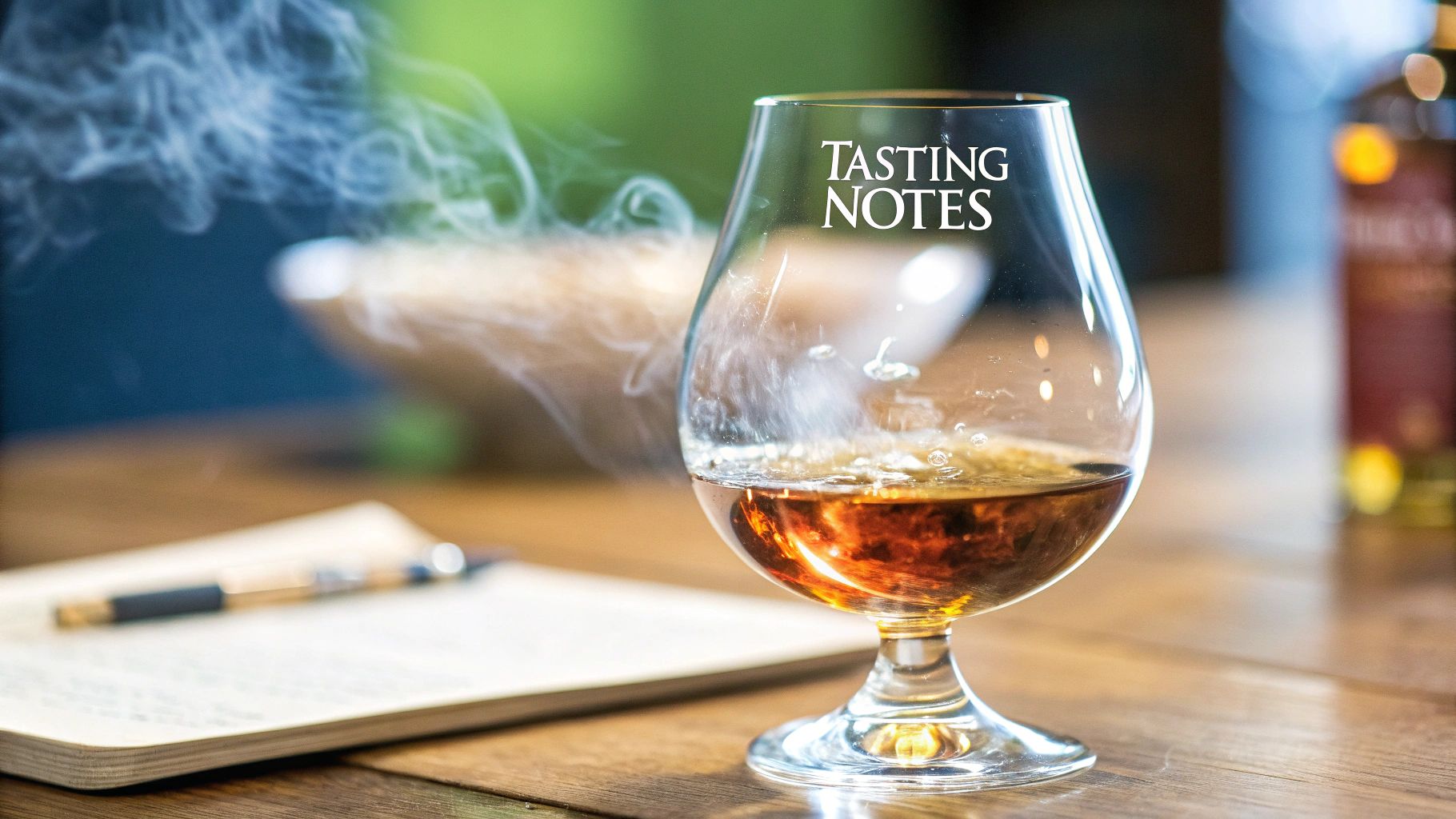
When you’re hunting for the perfect bourbon to sip straight, two of the most important clues on any label are the proof and the age statement. Think of them as the bourbon's vital statistics—a quick glance gives you a solid idea of the intensity and character waiting inside the bottle. Learning to read these numbers is a game-changer for picking a bourbon you’ll truly enjoy.
Proof is simply twice the alcohol by volume (ABV), and it’s a direct measure of the bourbon's power. But a higher proof isn't just about more booze; it often means a richer, more concentrated flavor. With less water to dilute the spirit's natural oils and flavor compounds, you get a much bolder experience. It’s no wonder so many seasoned drinkers lean toward these more robust pours.
Navigating Bourbon Proof Levels
If you're just starting your journey into sipping whiskey, jumping straight to a barrel-proof or cask-strength bourbon can be a bit like diving into the deep end. These are bottled at the exact proof they came out of the barrel, often soaring past 120 proof (60% ABV). While they pack an incredible flavor punch, that alcoholic heat can be overwhelming at first.
Tip for new whiskey drinkers: The beauty of a higher-proof bourbon is control. You can add a few drops of water yourself, gently dialing back the heat and unlocking new layers of aroma and taste that the alcohol was hiding. It puts you in the driver’s seat.
A fantastic middle ground is Bottled-in-Bond. This designation is a stamp of quality, guaranteeing the bourbon is 100 proof, comes from a single distillery and a single distilling season, and has been aged for at least four years. It hits that sweet spot of robust flavor and approachability. A lot of great American craft whiskey brands offer exceptional Bottled-in-Bond expressions perfect for sipping.
For a prime example of a high-proof titan, you can't do much better than George T. Stagg from the Buffalo Trace Antique Collection. This legendary bourbon is famously uncut and unfiltered, often clocking in above 130 proof. Its intense, layered flavor profile is the benchmark for what a powerful neat pour can deliver.
How Age Shapes the Spirit
While proof tells you about intensity, the age statement tells a story of transformation. Bourbon gets 100% of its color and a huge chunk of its flavor from aging in new, charred oak barrels. This magical dance between spirit and wood mellows the raw whiskey, softening its rough edges and coaxing out those classic bourbon notes we all love.
- Younger Bourbons (2-4 years): These tend to be brighter and more grain-forward, with light touches of caramel and vanilla just starting to emerge.
- Mid-aged Bourbons (5-10 years): This is often considered the sweet spot. Here you'll find a beautiful balance of sweet caramel, rich vanilla, and developing notes of oak and spice.
- Older Bourbons (12+ years): With more time in the barrel, these develop deep, complex flavors of dark chocolate, worn leather, and rich tobacco. But there’s a catch—leave it in too long, and the oak can take over, making the bourbon bitter and tannic.
Older doesn't automatically mean better. The trick is finding that perfect balance between maturity and vibrancy that hits just right for your palate. The relationship between whiskey and its barrel is a fascinating process, and you can learn more about how wood is whiskey's best friend in our dedicated article.
Decoding Bourbon Flavor Profiles
Every bottle of bourbon tells a story, and learning to read that story is how you find the perfect pour. Think of a distiller like a chef. The recipe they start with—the mash bill—is the foundation of the bourbon's entire character. Getting a handle on these grain recipes is like having a treasure map that leads you straight to the flavors you’ll love.
By law, every bourbon mash bill has to be at least 51% corn. That's where the spirit gets its classic, underlying sweetness. But it's the other grains, the "flavoring grains," where distillers really get to play and show their creativity. This is what creates the two main paths in the world of bourbon flavor.
High-Rye vs. Wheated Bourbons
The choice between rye and wheat as the main flavoring grain is a massive fork in the road for bourbon. One isn’t better than the other; they just create two totally different experiences for your palate.
- High-Rye Bourbons: When a healthy dose of rye (15-35% is typical) joins the corn, it brings the spice. We're talking about lively notes of black pepper, cinnamon, and even a little mint. These bourbons feel robust, complex, and often have a finish that leaves a memorable, spicy tingle.
- Wheated Bourbons: Swap that rye for wheat, and you get a much softer, gentler bourbon. Wheat lends a creamy, almost bready sweetness with flavors like honey, buttery toffee, and caramel. These "wheaters" are famously smooth and easy to sip, making them a fantastic gateway for anyone just starting to drink bourbon neat.
Of course, the grain is just the beginning. The time a bourbon spends aging in a barrel builds on these initial flavors, deeply influencing its final profile and, often, its price.
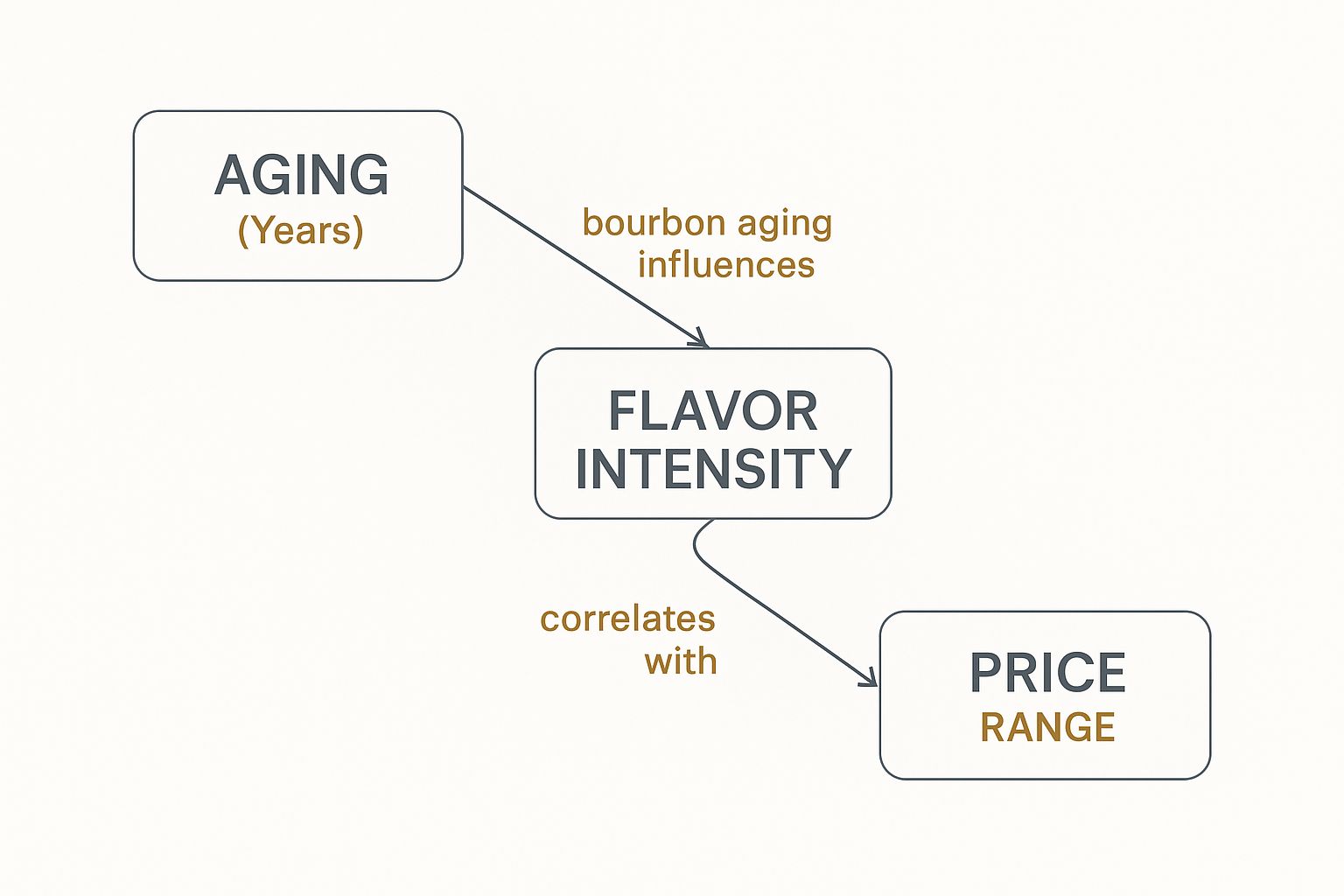
As you can see, more time in the barrel generally dials up the intensity and complexity of the flavors, which is why older bourbons tend to cost a bit more.
The Four Main Flavor Families
Beyond the specific grains, you can sort almost any bourbon flavor into one of four main categories. When you're tasting, see if you can pick out which of these families is taking the lead.
Learning to identify these flavor pillars is like learning the primary colors. Once you can spot them, you start to see the million different ways distillers can blend them into a masterpiece.
- Sweet: These are the notes that make bourbon so inviting, like walking into a candy shop. You'll find caramel, vanilla, rich honey, brown sugar, and maple syrup here.
- Spicy: This is the kick that comes from the rye grain and the char on the inside of the barrel. It shows up as cinnamon, clove, black pepper, and nutmeg.
- Fruity & Floral: These are often the more subtle, delicate notes that can be a fantastic surprise. Think of cherry, crisp apple, orange peel, and sometimes even hints of rose or mint.
- Oaky & Earthy: These deep, grounding flavors come straight from the wood. They’re the notes of toasted oak, worn leather, rich tobacco, dark chocolate, and roasted nuts.
The real magic happens when a distiller manages to weave these elements together. If you're curious about how they pull it off, you can learn more about the art of blending and creating complex whiskey flavors from the pros. Once you start understanding these profiles, you’re no longer just taking a shot in the dark—you're making a choice you know you'll enjoy.
Top Bourbons for Drinking Straight
Alright, you've got the theory down. Now for the best part—actually pouring a glass. Finding the "best" bourbon to drink straight is a deeply personal quest, but every journey needs a starting point. Think of this list as a trusted map to some truly fantastic bottles.
I’ve broken down my recommendations into a few key categories. Whether you're a new whiskey drinker, hunting for a killer value, or ready to see what the American craft whiskey scene has to offer, there's something here for you.
Best for Beginners
If you're new to sipping bourbon neat, you want something that invites you in, not something that punches you in the face. These picks are known for being smooth, balanced, and approachable—they show you what great bourbon is all about without overwhelming your palate.
- Elijah Craig Small Batch: This is a classic for good reason. It’s got all those lovely vanilla, sweet fruit, and faint mint notes wrapped up in a smooth, easy-to-sip package. At around 94 proof, it has enough character to be interesting but won't burn on the way down.
- W.L. Weller Special Reserve: This is a "wheated" bourbon, meaning wheat is the secondary grain instead of rye. The result? An exceptionally soft and sweet profile. It's famous for its gentle notes of honey, butterscotch, and caramel, making it one of the most welcoming introductions to straight whiskey you can find.
Great Value Sippers
You absolutely do not need to drain your bank account to find a high-quality bourbon that’s perfect for sipping. These bottles consistently perform like they cost twice as much, offering complexity and depth that'll make you feel like you got away with something.
A perfect example is Old Forester. This brand has been around since 1870 and was the first to sell bourbon exclusively in sealed bottles to guarantee you were getting the real deal. Their flagship Old Forester 100 Proof is a phenomenal value, packing a ton of robust flavor while staying impressively smooth. If you want to dive deeper, you can explore the history of this top-ranked bourbon brand and see how it earned its reputation.
When you're hunting for a great value sipper, balance is everything. Look for bourbons that are at least four years old and bottled at 100 proof. The "Bottled-in-Bond" designation is a fantastic clue that you’re getting a mature, full-flavored spirit without the premium price tag.
Exceptional Craft Choices
For those looking to explore spirits with real personality, the American craft whiskey scene is where the action is. These smaller distilleries aren't afraid to experiment with unique grains, aging methods, and mash bills to create bourbons that are truly one-of-a-kind.
- Frey Ranch Straight Bourbon: This is a true "farm-to-glass" operation out of Nevada, using grains they grow on their own land. Its four-grain recipe (corn, wheat, rye, and barley) creates a wonderfully complex profile with notes of citrus, honey, and a delightful spicy finish. It’s a taste of place.
- New Riff Single Barrel Bourbon: These folks are serious about quality. They bottle every bourbon without chill-filtration, which preserves the whiskey's rich texture and full flavor. Each single barrel is its own unique experience, but you can always count on finding bold notes of butterscotch, rye spice, and dark fruit.
Diving into these craft options is an incredible way to discover the huge diversity of flavors coming from small, passionate producers all across the country.
To help you navigate these excellent choices, I've put together a quick-reference table. It lays out our top recommendations side-by-side, giving you a snapshot of their style, proof, and what you can expect in the glass.
Recommended Bourbons for Straight Sipping
| Bourbon Name | Category and Style | Approximate Proof | Dominant Flavor Notes |
|---|---|---|---|
| Elijah Craig Small Batch | Beginner-Friendly (Rye Bourbon) | 94 | Vanilla, sweet fruit, mint, oak |
| W.L. Weller Special Reserve | Beginner-Friendly (Wheated Bourbon) | 90 | Honey, butterscotch, soft caramel |
| Old Forester 100 Proof | Great Value (High-Rye Bourbon) | 100 | Banana, caramel, spicy oak, vanilla |
| Frey Ranch Straight Bourbon | Craft Choice (Four-Grain) | 90 | Citrus, honey, baking spice, leather |
| New Riff Single Barrel | Craft Choice (High-Rye Bourbon) | 105-115 | Butterscotch, rye spice, dark fruit, oak |
This table should serve as a great starting point, but remember, the ultimate goal is to find what you enjoy. Use these as benchmarks as you continue to explore the vast and rewarding world of straight bourbon.
How to Find Your Perfect Pour
The hunt for the best bourbon to drink straight is a personal adventure, not a destination. Forget the idea of finding one single "best" bottle out there. The real prize is figuring out what makes your own palate sing. It's a journey about trusting your taste, not just following someone else's top-ten list.
Think of yourself as your own personal bourbon curator. The last few sections gave you the tools—now it’s time to put them to work and start building a foundation of experience.
Your Bourbon Exploration Checklist
For anyone new to whiskey, this simple approach can turn what feels like an intimidating task into a seriously enjoyable hobby. The key is not to try and taste everything all at once. Instead, be methodical, be curious.
- Start with Approachable Proofs: Begin with bourbons bottled in the 90-100 proof range. This is the sweet spot. It's got plenty of rich flavor without the intense alcoholic heat of a barrel-proof monster, letting you actually focus on what you're tasting.
- Experiment with Water: Add a single drop of water to your glass. It sounds simple, but this tiny action can completely transform the bourbon. It often softens the alcohol burn and unlocks subtle new aromas and flavors that were hiding.
- Explore Different Mash Bills: Try a classic, spicy high-rye bourbon one week. The next, pour a soft, sweet wheated bourbon. Comparing them side-by-side is the absolute fastest way to learn if you lean towards spice or sweetness in your whiskey.
Keep an eye out for smaller American craft whiskey distilleries, too. Many of them are playing with unique mash bills that offer an exciting change of pace from the big legacy brands.
Ultimately, your palate is the only judge that matters. Trust it, stay curious, and enjoy the delicious process of finding the pour that’s uniquely yours.
Common Questions About Sipping Bourbon
Diving into the world of sipping bourbon can stir up a few questions, no matter if you're a seasoned pro or just getting your feet wet. Getting the right answers helps you pour with confidence and pull more enjoyment out of every single glass.
Here are a few of the most common things we get asked.
What Is the Best Temperature to Serve Bourbon Neat?
Bourbon really shows its true colors when you serve it at room temperature, which is generally somewhere between 60-65°F (15-18°C).
If it’s too cold, the chill mutes all those complex aromas and flavors. You end up hiding the very notes of caramel, spice, and oak you came for. Serving it neat at room temp keeps the spirit's natural oils active, delivering the full sensory experience the distiller worked so hard to create.
Can I Add Water or Ice to a Good Sipping Bourbon?
Absolutely. While drinking it "neat" is the purest way to taste what's in the bottle, the best way to enjoy your bourbon is exactly how you like it.
Adding a few drops of water is actually a pro move. It can lower the proof just enough to "open up" the bourbon, releasing new aromatic compounds and softening the alcohol's kick. This works wonders on higher-proof bottles.
If you just have to have your drink chilled, go for a single large ice cube. It melts much slower than a handful of smaller cubes, cooling the spirit down with minimal dilution and preserving the integrity of a great sipping bourbon.
Remember, the goal is to enhance your experience, not drown the spirit. Start with a neat pour, then experiment to find what you like best.
What Does "Straight Bourbon" Mean on a Label?
Seeing the term "straight bourbon" on a label is a good thing. It’s a legal stamp of quality and transparency.
To earn that title, the whiskey has to be aged for at least two years in new, charred oak barrels. On top of that, if it’s aged for less than four years, the distillery is required to print the exact age statement right on the bottle.
This guarantees a certain level of maturity and proves the maker is following the rules. It's a reliable sign you’re picking up a quality bottle, which is why so many of the best American craft whiskey producers are proud to label their spirits this way.
Ready to discover your next favorite bourbon without all the guesswork? Blind Barrels sends you curated, blind tasting kits featuring top-shelf American craft whiskeys. It’s the perfect way to let your palate lead and find what you truly love. Explore our tasting experiences and start your adventure today.
